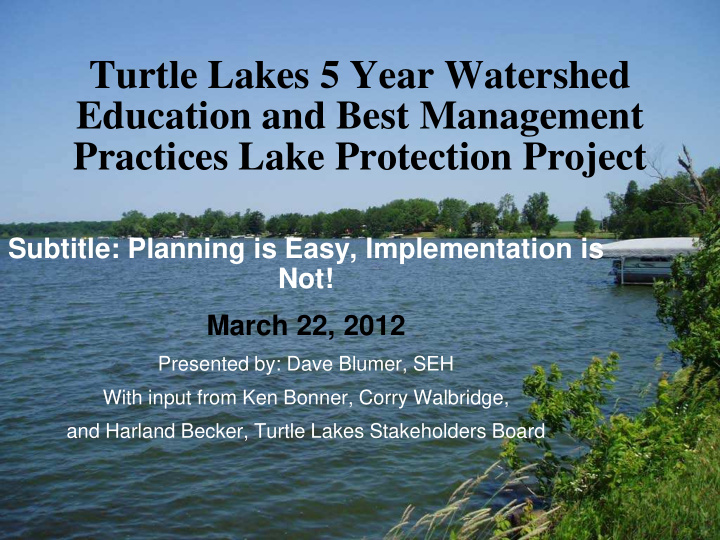



Turtle Lakes 5 Year Watershed Education and Best Management Practices Lake Protection Project Subtitle: Planning is Easy, Implementation is Not! March 22, 2012 Presented by: Dave Blumer, SEH With input from Ken Bonner, Corry Walbridge, and Harland Becker, Turtle Lakes Stakeholders Board
Why? -2010 303(d) Impaired waters listing (total phosphorus) NPS -Previous studies Turtle Lakes Watershed -Approx. 5000 acres -Approx 3000 in agricultural practices each year -Approx 60% of that area in row crops -6-10 active agricultural producers
Dairy farmers and crop farmers (owned and rented ground) Well-developed shoreline on both lakes
Project Particulars • $305,420 5-year project (2010-2014) • $200,000 granted from the state from the Lake Management Planning and Protection Program • $157,500 available for reimbursement of eligible project costs • $42,500 to cover water sampling costs • Donated Services = $39,860 • Volunteer Time ($12.00/hr) = $54,388
Project Components • Farmer Education • “No Till” Farmers Incentive Program • Agricultural Best Management Practices Cost-sharing • Riparian Owner Education • Shoreline Best Management Practices Project Cost-sharing
More Project Components • Expanded Water Quality Monitoring in both lakes • Tributary Monitoring • Aquatic Plant Management Planning for both lakes • Overall Project Management • Best Management Practices Stakeholders Board
Partners/Participants • Lower Turtle Lake Management District • Upper Turtle Lake Association • Lower Turtle Lake Association • Turtle Lakes Watershed Farmers • Barron County Soil and Water Conservation Department • Town of Almena • UW-Extension Agricultural Agent • Wisconsin Department of Natural Resources • Green Frog Consulting • Short Elliot Hendrickson, Inc (SEH)
Nine Member Stakeholders Board Lower Turtle Lake Management District (2 members) Lower Turtle Lake Association/At large (1 member) Upper Turtle Lake Association (2 members) Local Farmers (2 members) Barron County Soil and Water Conservation Department (1 member) Project Consultant (1 member) *WDNR Liaison
“If you build it, they will come!” 1989 film Field of Dreams, starring Kevin Kostner They Didn’t!!
Let’s Give Some Money Away!! We Couldn’t!!
• No till just makes sense! Everyone should take advantage of it! – High corn prices makes incentive payments less appealing – Tradition – Change means more work, new equipment – Negative stereotype that no till loses money – In person, one on one contact needed, letters just don’t cut it – Time is a valuable entity to farmers • Best Management Practices Projects – Must identify and design projects – What is reasonable compensation? – Multiple levels of approval – Show me what others are doing, what are lake people doing – Requires legal contracts including deed restrictions, notary – Must meet all local, county, state, and federal guidelines in order to be reimbursable in the grant – Requires meticulous record keeping, follow-up
• Shoreland Improvement Projects – Identifying and classification of interested parties – Completing shoreland site evaluations • Must meet local, county, state, and federal guidelines in order to be reimbursable • These guidelines were identified to a greater extent in 2011 – Implementing shoreland improvement projects with grant dollars requires perpetual property deed restrictions • Creation of these documents – No money to support implementation without grant dollars
No Till Incentives, Cover Crop, and BMP payments to date • No Till Incentives BMP Projects (2011-12) Payments (2010-11) - one farm – Two farmers - included roof runoff – $4,742.50 diversion, grassed waterways, crowning of • Cover Crop driveways, fencing out of Payments (2011) livestock, and nutrient – Two farmers management planning – $947.66 - 70% Project reimbursement - 30% Landowner match - $11, 224.00
Riparian projects to date • Preliminary boat landing site visits – Not completed yet • Seven private property site evaluations completed – None implemented yet – None planning to use grant dollars to help support implementation • Shoreland Improvement Interest Survey – Distributed to property owners on both lakes
Educate and inform, repeat, and then do it again….and again….and again….and again
Education activities completed to date • Riparian • Agricultural – Kickoff Breakfast – Farmers’ Dinner – Lake Fair – Farmer Letters – Site tours – Farmer Meetings – Newsletters – Site Tours – AIS monitoring – In person visits – Watercraft inspection – Water quality monitoring – Boat landing pre- evaluations
Administration
• Stakeholders Board – Individual project approvals – Tracking volunteer and donated services – Input and ideas – Working with sub-contractors – Reporting back to respective organizations – Tracking progress • Finances – Tracking expenditures – Cutting checks – Making money available (spent first, then reimbursed) – Seeking project reimbursement • Volunteer and donated services
How are we addressing these issues? • More personal contact with farmers; farmer to farmer contact • Shoreland Improvement Workshop with tree/shrub giveaway • Arranging to provide no till planting services at no charge to the participant • Setting up a side by side no till/conventional till comparison project • Non-grant related pot of money set aside for riparian assistance • Post riparian site evaluation surveys
Some Lessons Learned!! • Don’t just assume that a project will work smoothly, regardless of how it looks on paper! – Less grandiose ideas, keep it close to home • Do greater planning before entering into a project of this nature. – Get a better idea of the level of participation that can be expected – Thoroughly explore existing resources before entering into a project • Triple the expected time to administer the project. • Work closely with all the partners, they make a project like this happen.
Recommend
More recommend